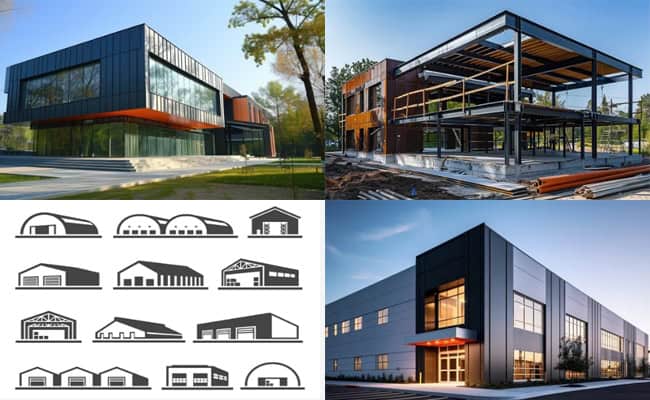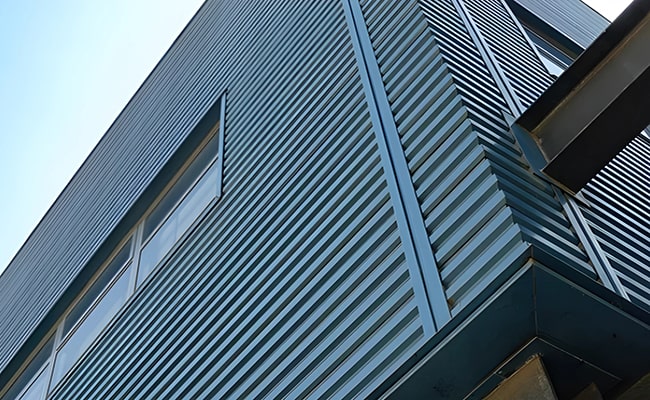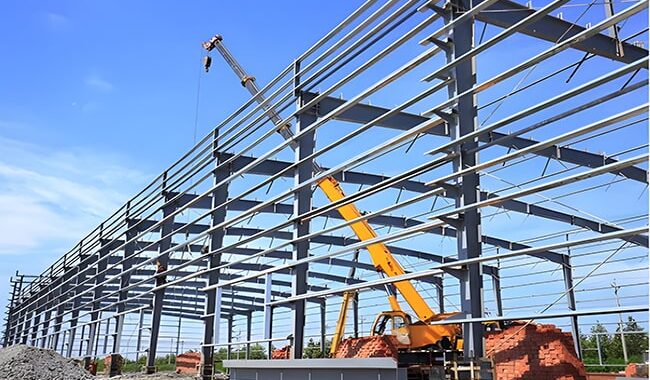In the construction of modern storage facilities, steel structure warehouses have become one of the mainstream building forms due to…
Prefabricated metal buildings are engineering structures with structural steel as the primary load-bearing system.
Steel structures mainly comprise steel beams, columns, trusses, and other components made of section steel and steel plates. Welds, bolts, or rivets usually connect each component.

Applications of prefabricated metal buildings:
Industrial buildings: factories, warehouses, etc.
Commercial buildings: shopping malls, conference and exhibition centers, etc.
Public buildings: office buildings, schools, hospitals, etc.
Civil construction: residential.
Technical characteristics of Prefabricated metal buildings
Material selection:
Prefabricated metal buildings primarily use steel and aluminum. Steel is suitable for large industrial and high-rise buildings due to its high strength, durability, and recyclability. Aluminum is often used in small and special-purpose buildings because of its lightweight, corrosion resistance, and easy processing. In addition, modern prefabricated metal buildings also use materials such as galvanized steel and aluminum alloys, which improve durability and corrosion resistance.
Design and manufacturing:
The design and manufacturing process for prefabricated metal buildings is highly standardized. Computer-aided design (CAD) software is used for detailed planning and simulation to ensure component accuracy and structural stability during the design phase. During the manufacturing stage, components such as cutting, welding, and drilling are completed in the factory. A strict quality control system ensures the consistency and high quality of the components.
Assembly and construction:
Prefabricated metal buildings can be assembled and constructed quickly and with little disruption. After the components are prefabricated in the factory, they are transported to the construction site for rapid assembly. Modern bolting technology makes the assembly process more accessible and safer, facilitating disassembly and relocation. This efficient construction method shortens the construction period and reduces the impact on the surrounding environment.
Case Study: Successful Prefabricated Metal Building Project
Steel Plant Workshop Construction Project
This project used prefabricated metal buildings to build several large production workshops and storage areas. Steel structures shortened the construction period by 40% and reduced the construction cost by 20%. The flexibility and rapid construction advantages of steel structures ensured the smooth completion of the project.
A Shopping Center Construction Project in the United States
This project involved the construction of a steel structure frame. The shopping center design has a large span of space, and steel structures provide the necessary space and flexibility. The project was completed within two years, significantly improving the return on investment.
An Office Building Project in Europe
This office building project uses a steel structure. The overall building height is 150 meters. The steel structure not only provides ample space for use but also reduces the foundation cost by reducing the weight of the structure.
Features of prefabricated metal structures:
1. The material has high strength, and its weight is light.
Steel has high strength and high elastic modulus. Compared with concrete and wood, the ratio of its density to yield strength is relatively low. Therefore, under the same stress conditions, the steel structure has a small component section, is lightweight, is easy to transport and install, and is suitable for large spans, high heights, and heavy loads.
2. Steel has toughness, good plasticity, uniform material, high structural reliability,
Steel is suitable for withstanding impact and dynamic loads and has good earthquake resistance. Its internal structure is uniform and close to an isotropic homogeneous body. The actual working performance of the steel structure is relatively consistent with the calculation theory. Therefore, the steel structure is highly reliable.
3. Steel structure manufacturing and installation are highly mechanized.
Steel structure components are easy to manufacture in factories and assemble on construction sites. The factory’s mechanized manufacturing of steel structure components has high precision, high production efficiency, fast construction site assembly, and a short construction period. Steel is the most industrialized structure.
4. The steel structure has good sealing performance.
Because the welded structure can be completely sealed, it can be made into high-pressure vessels, large oil pools, pressure pipelines, etc., with good air and water tightness.
5. Steel structures are heat-resistant but not fire-resistant.
When the temperature is below 150°C, the properties of steel change very little; therefore, the steel structure is suitable for hot workshops. Still, when the structure’s surface is subject to heat radiation of about 150°C, it must be protected by heat insulation panels; when the temperature is between 300℃ and 400℃, steel’s strength and elastic modulus decrease significantly. When the temperature is around 600℃, the strength of steel tends to zero. The steel structure must be protected with refractory materials in buildings with special fire protection requirements to improve the fire resistance rating.
6. The steel structure has poor corrosion resistance, especially in environments with humid and corrosive media, and is prone to rust.
Generally, steel structures must be rust removed, galvanized, or painted and maintained regularly. Special measures such as “zinc block anode protection” must be adopted for offshore platform structures in seawater to prevent corrosion.
7. It is low-carbon, energy-saving, green, environmentally friendly, and reusable. Demolishing steel structures produces almost no construction waste, and the steel can be recycled and reused.

Advantages of Prefabricated Metal Buildings
Compared with concrete structures, prefabricated metal buildings have the following advantages in economic performance:
1. The steel structure is light in weight.
The self-weight of high-rise steel structures is generally 1/2~3/5 of the self-weight of high-rise concrete structures. Reducing the structure’s self-weight can reduce the seismic force, thereby reducing the structural design’s internal force. In addition, reducing the weight of the structure can also reduce the cost of the foundation. This advantage is more evident in soft soil areas in the south.
2. Steel structure materials have high strength.
Compared with concrete structures, steel structure columns have a smaller cross-sectional area, which can increase the effective use area of the building. Generally, the cross-sectional area of high-rise steel structure columns accounts for about 3% of the building area. In comparison, the cross-sectional area of high-rise concrete structural columns accounts for 7% to 9% of the building area.
3. Steel structure construction is fast.
Generally, one layer of high-rise steel structures is completed every four days on average, while one layer of high-rise concrete structures is completed every six days on average; that is, the construction speed of steel structures is approximately 1.5 times that of concrete structures.
Shortening the structural construction period can put the entire building into use earlier and shorten the loan repayment time for construction loans, thereby reducing loan interest.
For example, in the past few years, the investment payback period of high-end office buildings was about three years. If the steel structure can be used half a year earlier than the concrete structure, it is approximately equivalent to saving 18% of investment by using the steel structure compared with the concrete structure.
4. There are many pipes in high-rise buildings.
If a steel structure is used, holes can be made in the beams to pass through the pipes. However, if a concrete structure is used since the beams are unsuitable for opening holes, pipes usually pass under the beams, thus occupying a certain amount of space.
Therefore, when the floor height is the same, the floor height of the steel structure can be smaller than that of the concrete structure, which can reduce the area of the peripheral retaining wall, save the energy required for indoor air conditioning, and reduce building maintenance and usage fees. In addition, under the condition that the total height of the building is determined, the steel structure can build several more floors than the concrete structure, thereby increasing the building area.
FAQS for Prefabricated Metal Buildings
Q: Is the prefabricated metal buildings more expensive than the traditional building?
A: The initial construction cost of a steel structure building is usually 5% to 15% higher than that of a traditional building. However, by shortening the construction period (saving financial costs), improving space utilization (increasing rental area), and reducing operation and maintenance costs (energy saving and easy maintenance), the life cycle cost of steel structure buildings can be reduced by 20% to 30%. Therefore, in the long run, the economic benefits of steel structure buildings are more prominent.
Q: How to solve the thermal bridge effect of prefabricated metal buildings?
A: In order to effectively solve the thermal bridge effect, thermal bridge break connectors (whose thermal conductivity is ≤0.05W/m·K) are usually used, combined with external insulation systems (such as graphite polystyrene board and rock wool composite insulation layer). This solution can not only improve the thermal isolation performance of steel structure buildings, but also meet the energy efficiency standards of passive buildings, effectively reducing the energy consumption of buildings.
Q: What is the floor height limit of steel structure buildings?
A: When using steel tube concrete composite structure, the theoretical construction height of steel structure houses can reach 1,500 meters. At present, the world’s tallest building is the Burj Khalifa in Dubai (828 meters), and the tallest building under construction in China is Qingdao Haitian Center (369 meters). The successful implementation of these buildings demonstrates the wide application potential of steel structures in high-rise buildings.














